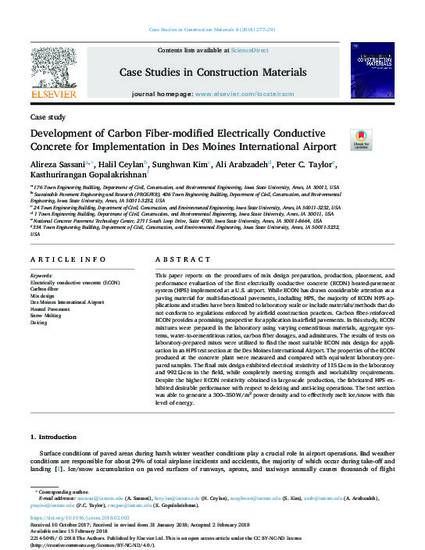
This paper reports on the procedures of mix design preparation, production, placement, and performance evaluation of the first electrically conductive concrete (ECON) heated-pavement system (HPS) implemented at a U.S. airport. While ECON has drawn considerable attention as a paving material for multi-functional pavements, including HPS, the majority of ECON HPS applications and studies have been limited to laboratory scale or include materials/methods that do not conform to regulations enforced by airfield construction practices. Carbon fiber-reinforced ECON provides a promising prospective for application in airfield pavements. In this study, ECON mixtures were prepared in the laboratory using varying cementitious materials, aggregate systems, water-to-cementitious ratios, carbon fiber dosages, and admixtures. The results of tests on laboratory-prepared mixes were utilized to find the most suitable ECON mix design for application in an HPS test section at the Des Moines International Airport. The properties of the ECON produced at the concrete plant were measured and compared with equivalent laboratory-prepared samples. The final mix design exhibited electrical resistivity of 115 Ω-cm in the laboratory and 992 Ω-cm in the field, while completely meeting strength and workability requirements. Despite the higher ECON resistivity obtained in large-scale production, the fabricated HPS exhibited desirable performance with respect to deicing and anti-icing operations. The test section was able to generate a 300–350 W/m2 power density and to effectively melt ice/snow with this level of energy.
Available at: http://works.bepress.com/halil_ceylan/310/

This article is published as Sassani, A., Ceylan, H., Kim, S., Arabzadeh, A., Taylor, P. C., and Gopalakrishnan, K. (2018). Development of Carbon Fiber-modified Electrically Conductive Concrete for Implementation in Des Moines International Airport. Case Studies in Construction Materials, 8: 277-291. DOI: 10.1016/j.cscm.2018.02.003. Posted with permission.